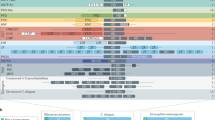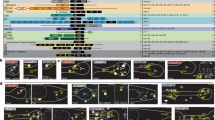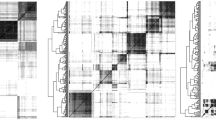Abstract
HOMOEOBOX-containing genes control cell identities in par-ticular spatial domains, cell lineages, or cell types during the development of Drosophila1,2 and Caenorhabditis elegans3–5, and they probably control similar processes in vertebrates6–9. More than 80 genes with homoeoboxes that have sequence similarities ranging from 25 to 100% have been isolated by genetic means or by DNA hybridization to previously isolated genes10. We synthesized 500–2,000-fold degenerate oligonucleotides corre-sponding to a set of well-conserved eight amino acid sequences from the helix-3 region of the homoeodomain11. We screened C. elegans genomic libraries with these probes and identified 49 putative homoeobox-containing loci. DNA sequencing confirmed that eight out of ten selected loci had sequences corresponding to the conserved helix-3 region11 plus additional flanking sequence similarity. One of these genes contained a sequence corresponding to a complete pou-domain12 and another was closely related to the homoeobox-containing genes caudal/cdx-113,14. The putative homoeobox loci were mapped to the physical contig map of C. elegans15,16, allowing the identification of potentially correspond-ing genes from the correlated genetic map. We estimate that the number of homoeobox-containing genes in C. elegans is at least 60, constituting ∼1% of the estimated total number of genes17.
This is a preview of subscription content, access via your institution
Access options
Subscribe to this journal
Receive 51 print issues and online access
$199.00 per year
only $3.90 per issue
Buy this article
- Purchase on Springer Link
- Instant access to full article PDF
Prices may be subject to local taxes which are calculated during checkout
Similar content being viewed by others
References
Akam, M. Development 101, 1–22 (1987).
Gehring, W. J. Science 236, 1245–1252 (1987).
Way, J. C. & Chalfie, M. Cell 54, 5–16 (1988).
Costa, M., Weir, M., Coulson, A., Sulston, J. & Kenyon, C. Cell 55, 747–756 (1988).
Finney, M., Ruvkun, G. & Horvitz, H. R. Cell 55, 757–769 (1988).
Cho, K. W. Y. et al. EMBO J. 7, 2139–2149 (1988).
Harvey, R. P. & Melton, D. A. Cell 53, 687–697 (1988).
Ruiz i Altaba, A. & Melton, D. A. Cell 57, 317–326 (1989).
Wright, C. V. E., Cho, K. W. Y., Hardwicke, J., Collins, R. H. & De Robertis, E. M. Cell (in the press).
Scott, M. P., Tamkun, J. W. & Hartzell III, G. W. BBA reviews on cancer Vol. 9, 25–48 (1989).
Bürglin, T. R. Cell 53, 339–340 (1988).
Herr, W. et al. Genes Dev. 2, 1513–1516 (1988).
Mlodzik, M. & Gehring, W. J. Cell 48, 465–478 (1987).
Duprey, P. et al. Genes Dev. 2, 1647–1654 (1988).
Coulson, A., Sulston, J., Brenner, S. & Karn J. Proc. Natn. Acad. Sci. U.S.A. 83, 7821–7825 (1986).
Coulson, A., Waterston, R., Kiff, J., Sulston, J. & Kohara, Y. Nature 335, 184–186 (1988).
Emmons, S. W. in The Nematode Caenorhabditis elegans (ed. Wood, W. B.) 47–79 (Cold Spring Harbor Laboratory, New York, 1988).
He, X. et al. Nature 340, 35–42 (1989).
Kamb, A., Weir, M., Rudy, B., Varmus, H. & Kenyon, C. Proc. Natn. Acad. Sci. U.S.A. 86, 4372–4376 (1989).
Graham, A., Papalopulu, N. & Krumlauf, R. Cell 57, 367–378 (1989).
Duboule, D. & Dollé, P. EMBO J. 8, 1497–1505 (1989).
Ferguson, E. L., Sternberg, P. W. & Horvitz, H. R. Nature 326, 259–267 (1987).
Ausubel et al. Current Protocols in Molecular Biology (Green Publishing Associates and Wiley-Interscience, New York, 1987).
Rosenberg, U. B. et al. Nature 319, 336–339 (1986).
Maniatis, T., Fritsch, E. F. & Sambrook, J. in Molecular Cloning: A Laboratory Manual (Cold Spring Harbor Laboratory, New York, 1982).
Wood, W. I., Gitschier, J., Lasky, L. A. & Lawn, R. M. Proc. Natn. Acad. Sci. U.S.A. 82, 1585–1588 (1985).
Cohen, S. M., Brönner, G., Küttner, F., Jürgens, G. & Jäckle, H. Nature 338, 432–434 (1989).
Rosa, F. M. Cell 57, 965–974 (1989).
Otting, G. et al. EMBO J. 7, 4305–4309 (1988).
Ruiz i Altaba, A. & Melton, D. A. Development 106, 173–183 (1989).
Kramer, J. M., Johnson, J. J., Edgar, R. S., Basch, C. & Roberts, S. Cell 55, 555–565 (1988).
Author information
Authors and Affiliations
Rights and permissions
About this article
Cite this article
Bürglin, T., Finney, M., Coulson, A. et al. Caenorhabditis elegans has scores of homoeobox-containing genes. Nature 341, 239–243 (1989). https://doi.org/10.1038/341239a0
Received:
Accepted:
Issue Date:
DOI: https://doi.org/10.1038/341239a0
This article is cited by
-
Homeobox genes and the specification of neuronal identity
Nature Reviews Neuroscience (2021)
-
Unique homeobox codes delineate all the neuron classes of C. elegans
Nature (2020)
-
Interactions between LHX3- and ISL1-family LIM-homeodomain transcription factors are conserved in Caenorhabditis elegans
Scientific Reports (2017)
-
Selection strategy and the design of hybrid oligonucleotide primers for RACE-PCR: cloning a family of toxin-like sequences from Agelena orientalis
BMC Molecular Biology (2007)
-
Effectiveness of specific RNA-mediated interference through ingested double-stranded RNA in Caenorhabditis elegans
Genome Biology (2000)
Comments
By submitting a comment you agree to abide by our Terms and Community Guidelines. If you find something abusive or that does not comply with our terms or guidelines please flag it as inappropriate.



